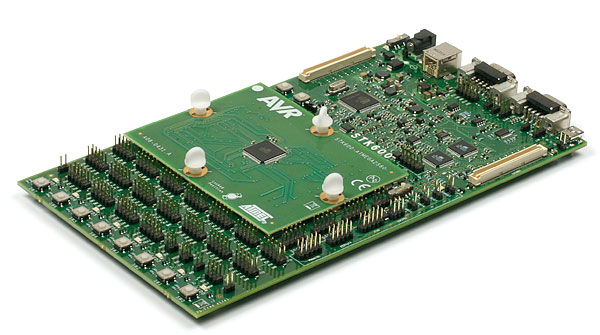3.2 Get the STK600 Starter Kit

| Device | Routing Card | Socket Card |
|---|---|---|
| ATmega3209 | STK600-RC048M-107 | STK600-QFN48 |
| ATmega3209 | STK600-RC048M-107 | STK600-TQFP48 |
| ATmega4809 | STK600-RC048M-107 | STK600-QFN48 |
| ATmega4809 | STK600-RC048M-107 | STK600-TQFP48 |
| ATmega1609 | STK600-RC048M-107 | STK600-QFN48 |
| ATmega1609 | STK600-RC048M-107 | STK600-TQFP48 |
For device support for other devices, refer to: http://www.microchip.com/STK600_Starter_Kit-Users_Guide
Web page: http://www.microchip.com/ATSTK600
Get the kit: https://www.microchipdirect.com/product/ATSTK600
Document/file:
- STK600 User Guide (.pdf)
Key features
- AVR® Studio 4/AVR32 Studio/AVR Studio 5/Atmel Studio Compatible
- USB Interface to PC for Programming and Control
- Powered from USB Bus or from an External 10-15V DC Power Supply
- Adjustable Target VCC (0-5.5V)
- Two Adjustable Reference Voltages with High Accuracy (0-5.0V, 10 mV res.)
- Clock Oscillator, Adjustable On-The-Fly from Atmel Studio (0-50 MHz, 0.1% res.)
- Serial In-System Programming (ISP) of tinyAVR and megaAVR® Devices
- PDI Programming of AVR XMEGA® Devices
- JTAG Programming of megaAVR, AVR XMEGA, and AVR UC3 Devices
- aWire Programming of AVR UC3 Devices
- ISP and JTAG Programming of AVR Devices in External Target Systems
- Flexible Routing and Socket Card System for Easy Mounting of all Supported Devices
- Eight Push Buttons for General Use
- Eight LEDs for General Use
- All AVR I/O Ports are Easily Accessible through Pin Header Connectors
- Expansion Connectors for Plug-In Modules and Prototyping Area
- On-Board 4 Mb DataFlash for Nonvolatile Data
- USB mini-AB (On-The-Go) Connector for AVR Devices with USB
- PHY and DSUB-9 Connector for RS-232 Interface
- PHY and DSUB-9 Connector for CAN Bus
- PHY and Header for LIN Bus
- Device Board with an ATmega2560 AVR Microcontroller Included
The STK600 User Guide describes how to power the kit and includes detailed information about board components, extension interface, and the hardware description.
